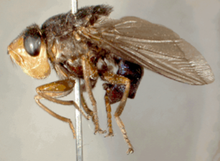Dermatobia hominis
| Dermatobia hominis | |
|---|---|

| |
| Adult female human botfly | |
| Scientific classification | |
| Domain: | Eukaryota |
| Kingdom: | Animalia |
| Phylum: | Arthropoda |
| Class: | Insecta |
| Order: | Diptera |
| Family: | Oestridae |
| Subfamily: | Cuterebrinae |
| Genus: | Dermatobia |
| Species: | D. hominis
|
| Binomial name | |
| Dermatobia hominis (Linnaeus Jr. in Pallas, 1781)
| |
| Synonyms | |
|
Oestrus hominis (Linnaeus Jr. in Pallas, 1781) | |
The human botfly, Dermatobia hominis (Greek δέρμα, skin + βίος, life, and Latin hominis, of a human), is a species of botfly whose larvae parasitise humans (in addition to a wide range of other animals, including other primates[1]). It is also known as the torsalo or American warble fly,[1] though the warble fly is in the genus Hypoderma and not Dermatobia, and is a parasite on cattle and deer instead of humans.
Dermatobia fly eggs have been shown to be vectored by over 40 species of mosquitoes and muscoid flies, as well as one species of tick[2] (However, the source for this is somewhat old, 2007, and slightly more recent literature seems to indicate they don't need a particular species of ticks, or at least makes no mention of them only being able to use one as a vector[3]). The female captures the mosquito and attaches its eggs to its body, then releases it. Either the eggs hatch while the mosquito is feeding and the larvae use the mosquito bite area as the entry point, or the eggs simply drop off the muscoid fly when it lands on the skin. The larvae develop inside the subcutaneous layers, and after about eight weeks, they drop out to pupate for at least a week, typically in the soil. The adults are large flies lacking mouthparts (as is true of other oestrid flies).
This species is native to the Americas from southeastern Mexico (beginning in central Veracruz) to northern Argentina, and Uruguay,[1] though it is not abundant enough (nor harmful enough) to ever attain true pest status. Normally the greatest risk they pose to humans is increasing the chances of infection. Since the fly larvae can survive the entire eight-week development only if the wound does not become infected, patients rarely experience infections unless they kill the larva without removing it completely.

Remedies
[edit]The easiest and most effective way to remove botfly larvae is to apply petroleum jelly over the location, which prevents air from reaching the larva, suffocating it. It can then be removed with tweezers safely after a day. White glue mixed with pyrethrin or other safe insecticides and applied to the spot of swelling on the scalp will kill the larvae within hours, as they must keep an air hole open, so will chew through the dried glue to do this, consuming the insecticide in the process.[citation needed]
Venom extractor syringes can remove larvae with ease at any stage of growth.[4] A larva has also been successfully removed by first applying several coats of nail polish to the area of the larva's entrance, weakening it by partial asphyxiation.[5] Covering the location with adhesive tape would also result in partial asphyxiation and weakening of the larva, but is not recommended because the larva's breathing tube is fragile and would be broken during the removal of the tape, leaving most of the larva behind.[5]
Oral use of ivermectin, an antiparasitic avermectin medicine, has proven to be an effective and noninvasive treatment that leads to the spontaneous emigration of the larva.[6] This is especially important for cases where the larva is located in inaccessible places such as inside the inner canthus of the eye.

See also
[edit]References
[edit]- ^ a b c "Human Bot Fly Myiasis" (PDF). U.S. Army Public Health Command (provisional), formerly U.S. Army Center for Health Promotion and Preventive Medicine. January 2010. Retrieved 2014-08-14.
- ^ Piper, Ross (2007). "Human Botfly". Extraordinary Animals: An Encyclopedia of Curious and Unusual Animals. Westport, Connecticut: Greenwood Publishing Group. pp. 192–194. ISBN 978-0-313-33922-6. OCLC 191846476. Retrieved 2009-02-13.
- ^ C. Roxanne Connelly, Stephanie K. Hill (2008). "human bot fly - Dermatobia Hominis". University Of Florida. Gainesville , Florida: University of Florida. Retrieved 2024-10-23.
- ^ Boggild, Andrea K.; Keystone, Jay S.; Kain, Kevin C. (August 2002). "Furuncular myiasis: a simple and rapid method for extraction of intact Dermatobia hominis". Clinical Infectious Diseases. 35 (3): 336–338. doi:10.1086/341493. PMID 12115102.
- ^ a b Bhandari, Ramanath; Janos, David P.; Sinnis, Photini (March 2007). "Furuncular myiasis caused by Dermatobia hominis in a returning traveler". The American Journal of Tropical Medicine and Hygiene. 76 (3): 598–9. doi:10.4269/ajtmh.2007.76.598. PMC 1853312. PMID 17360891.
- ^ Wakamatsu, Tais Hitomi; Pierre-Filho, P. T. P. (October 2005). "Ophthalmomyiasis externa caused by Dermatobia hominis: a successful treatment with oral ivermectin". Eye. 20 (9): 1088–90. doi:10.1038/sj.eye.6702120. PMID 16244643.
External links
[edit]- Case Report: Insect Bite Reveals Botfly Myiasis in an Older Woman
- human bot fly on the UF / IFAS Featured Creatures Web site
- Sampson, Christian E.; Maguire, James; Eriksson, Elof (February 2001). "Botfly Myiasis: Case Report and Brief Review". Annals of Plastic Surgery. 46 (2): 150–2. doi:10.1097/00000637-200102000-00011. PMID 11216610.
- Schwartz, Eli; Gur, Hanan (March 2002). "Dermatobia hominis myiasis: an emerging disease among travelers to the Amazon basin of Bolivia". Journal of Travel Medicine. 9 (2): 97–9. doi:10.2310/7060.2002.21503. PMID 12044278.
- Passos MR, Barreto NA, Varella RQ, Rodrigues GH, Lewis DA (June 2004). "Penile myiasis: a case report". Sexually Transmitted Infections. 80 (3): 183–4. doi:10.1136/sti.2003.008235. PMC 1744837. PMID 15169999.
- Denion E, Dalens PH, Couppié P, et al. (October 2004). "External ophthalmomyiasis caused by Dermatobia hominis. A retrospective study of nine cases and a review of the literature". Acta Ophthalmologica Scandinavica. 82 (5): 576–84. doi:10.1111/j.1600-0420.2004.00315.x. PMID 15453857. Archived from the original on 2012-12-16. Retrieved 2008-10-09.
- {{cite journal|vauthors=Stephanie K. Hill, C. Roxanne Connelly|title=Human Botfly - Dermatobia Hominis|
